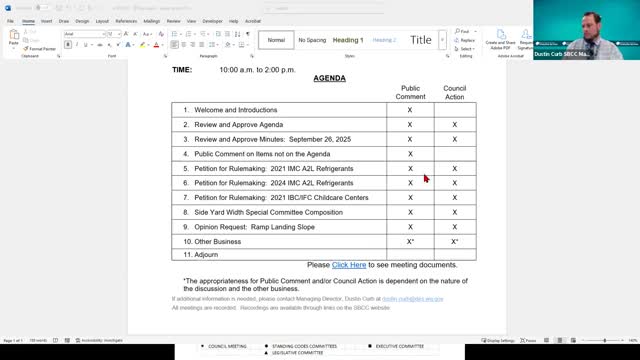Council adopts opinion: stair landing slope provision does not apply to ramp landings; references A117.1 guidance
October 17, 2025 | Building Code Council, Governor's Office - Boards & Commissions, Executive, Washington
This article was created by AI summarizing key points discussed. AI makes mistakes, so for full details and context, please refer to the video of the full meeting. Please report any errors so we can fix them. Report an error »

The Washington State Building Code Council on Oct. 17 adopted an opinion clarifying that the residential-code provision governing stairway landing slope (IRC 311.7.7) applies to stair landings only and does not set the maximum cross slope for ramp landings.
Staff prepared the opinion after a request from Spokane Valley and others who reported that, in some retrofit cases, a ramp terminates at a sloped driveway or sidewalk and the absence of explicit ramp-landing guidance has produced inconsistent local approaches. Council staff and members noted that accessibility standards incorporated in practice (ICC/ANSI A117.1) address ramp-landing cross slope and that A117.1 sets a tighter maximum (1:48) for ramp landings used for accessibility.
The council voted to adopt staff's technical answer: the IRC stairway landing provision is not applicable to ramps; jurisdictions seeking guidance should reference ICC/ANSI A117.1 for ramp-landing slope and cross-slope parameters. Council members said that, while the opinion answers the immediate interpretation question, the council should consider a code amendment in a future cycle to explicitly add ramp-landing cross-slope language to the residential code.
Why it matters: The adopted opinion gives plan reviewers and inspectors a clear reference (A117.1) for ramp-landing cross slope when evaluating accessibility-related ramps and helps jurisdictions manage retrofit installations (for example, home-entry ramps terminating at a driveway). The council also recognized that some adult-family homes and private residential situations may not be covered directly by federal ADA requirements, but referencing A117.1 provides a consistent technical baseline.
Next steps: The adopted opinion will be published in the council's opinion repository and staff recommended the council consider a permanent code amendment during a future code cycle to make ramp-landing requirements explicit in the residential code.
Attribution: Opinion language and references drawn from council staff memorandum and discussion recorded in the Oct. 17 meeting transcript.
Staff prepared the opinion after a request from Spokane Valley and others who reported that, in some retrofit cases, a ramp terminates at a sloped driveway or sidewalk and the absence of explicit ramp-landing guidance has produced inconsistent local approaches. Council staff and members noted that accessibility standards incorporated in practice (ICC/ANSI A117.1) address ramp-landing cross slope and that A117.1 sets a tighter maximum (1:48) for ramp landings used for accessibility.
The council voted to adopt staff's technical answer: the IRC stairway landing provision is not applicable to ramps; jurisdictions seeking guidance should reference ICC/ANSI A117.1 for ramp-landing slope and cross-slope parameters. Council members said that, while the opinion answers the immediate interpretation question, the council should consider a code amendment in a future cycle to explicitly add ramp-landing cross-slope language to the residential code.
Why it matters: The adopted opinion gives plan reviewers and inspectors a clear reference (A117.1) for ramp-landing cross slope when evaluating accessibility-related ramps and helps jurisdictions manage retrofit installations (for example, home-entry ramps terminating at a driveway). The council also recognized that some adult-family homes and private residential situations may not be covered directly by federal ADA requirements, but referencing A117.1 provides a consistent technical baseline.
Next steps: The adopted opinion will be published in the council's opinion repository and staff recommended the council consider a permanent code amendment during a future code cycle to make ramp-landing requirements explicit in the residential code.
Attribution: Opinion language and references drawn from council staff memorandum and discussion recorded in the Oct. 17 meeting transcript.
View full meeting
This article is based on a recent meeting—watch the full video and explore the complete transcript for deeper insights into the discussion.
View full meeting
